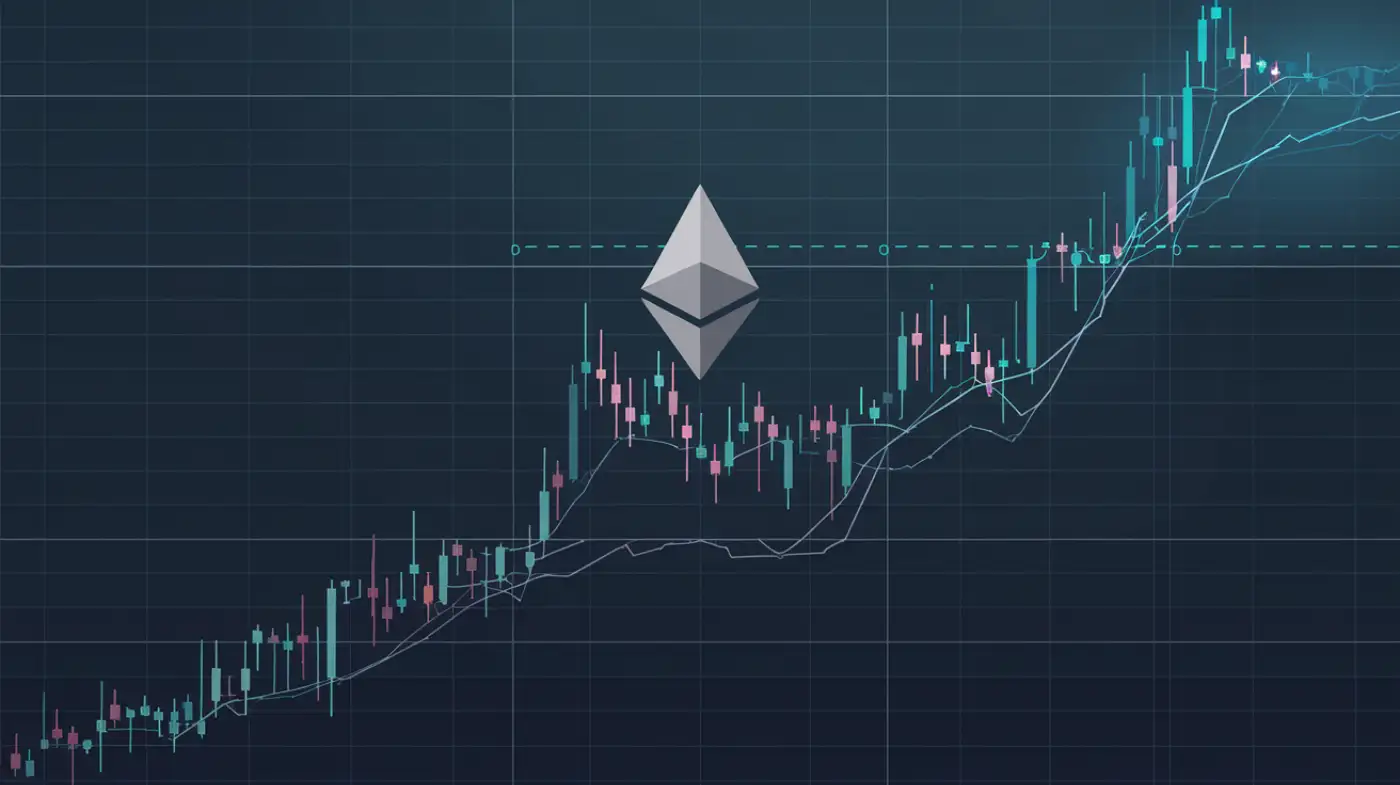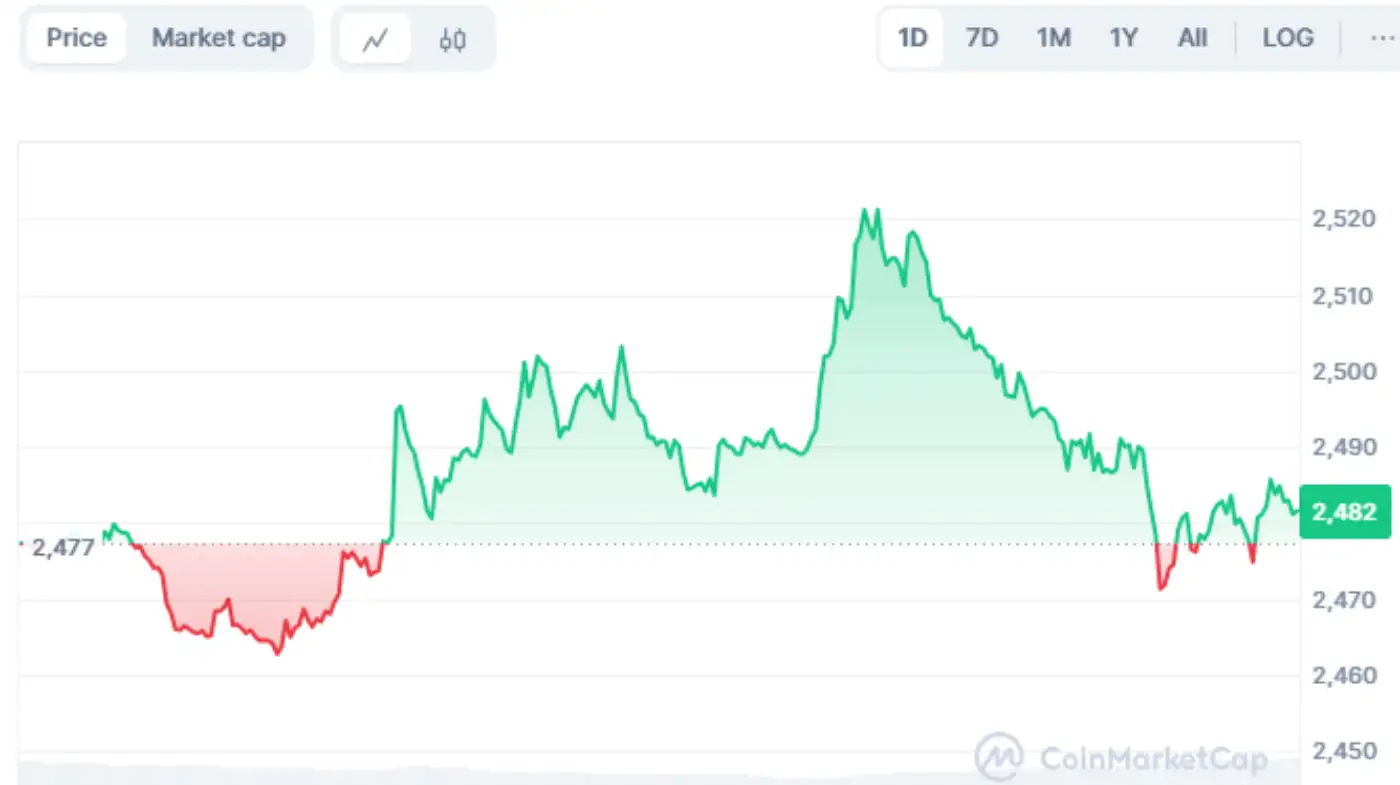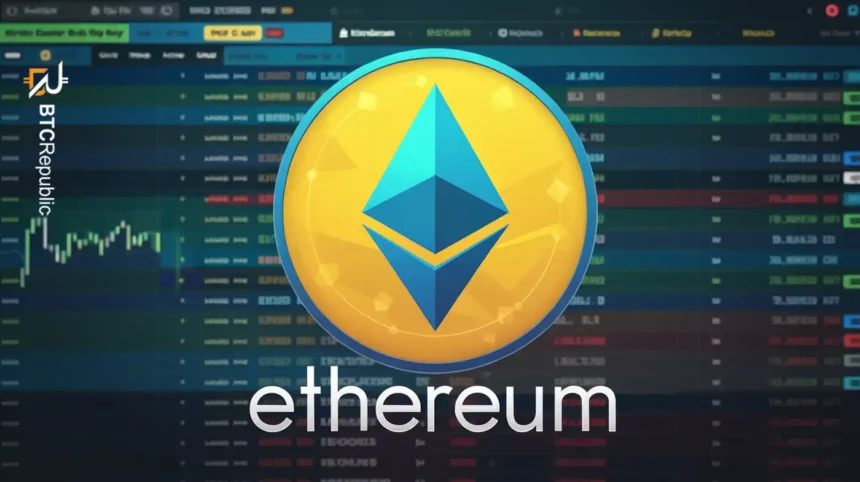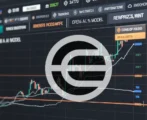Ethereum (ETH) is one of the top cryptocurrencies in the market and has been on the radar of investors, developers, and tech junkies ever since its release to the public in 2015.
It is famous for its pioneering smart contract functionality and its rich ecosystem of decentralized applications (dApps).
As such, it has become a bedrock of decentralized finance (DeFi) and the non-fungible token (NFT) explosion.
- Factors Influencing Ethereum’s Price
- Major Ethereum Events
- Ethereum Improvement Proposals (EIPs)
- The DAO Hack
- The DeFi Boom
- Transition To Proof Of Stake
- The NFT Explosion
- Introduction Of Spot Ethereum ETFs
- Regulatory Developments
- Ethereum Historical Performance And Current Market Trends
- Potential Scenarios For 2025
- Ethereum Price Prediction Table
- Expert Opinions On ETH Prices In 2025
- Conclusion
- FAQs
As a new year fast approaches, many enthusiasts may be wondering what Ethereum’s price will be then. Trying to guess the future value of any crypto is an intricate web of a host of factors, including market forces, technical developments, government decisions, and general economic conditions.
This guide offers a comprehensive overview of what 2025 may hold for Ethereum in terms of valuation.
Factors Influencing Ethereum’s Price

As with Bitcoin and all other cryptos, several factors can impact Ether prices positively or negatively. Below are some of them.
- Adoption of dApps and DeFi: The expansion of dApps and DeFi platforms creates demand for ETH because users need the coin to conduct transactions and to pay for smart contract execution.
- NFT market: The NFT craze (Ethereum is the dominant NFT platform) has caused a huge demand for ETH. And with high-profile NFT sales and more people joining the market, prices may skyrocket.
- Ethereum 2.0 and deflationary mechanisms: The transition to Ethereum 2.0, particularly the implementation of the Ethereum Improvement Proposal (EIP)-1559, introduced a mechanism that burns a portion of transaction fees, reducing the circulating supply over time. This downward pressure can have a favorable impact on prices if the demand is still there. Additionally, a shift to a Proof of Stake (PoS) consensus mechanism is a must for scalability, security, and sustainability. When upgrades are successful, investors become more confident, and the price goes up.
- Scalability solutions: Ongoing improvements in scalability, such as Layer 2 solutions (e.g., Optimistic Rollups, zk-Rollups), affect transaction speed and costs. Better performance would lead to more user adoption and, in turn, more demand for ETH.
- Fear and greed: The psychological aspects of trading can lead to price volatility. When people are feeling bullish, they tend to go on buying binges, while fear can cause massive sell-offs. Indicators such as the Fear and Greed Index are used to measure market sentiment.
- Public perception: This has to do with opinions and how they drastically impact prices, for example, a simple chat on Twitter or Reddit. Good news or even endorsements from prominent individuals can cause prices to skyrocket, but bad news can cause prices to plummet.
- Legislation: Any regulatory changes on cryptocurrencies can drastically affect the price. Favorable regulations, like clearer guidelines or pro-crypto laws, can cause prices to rise, while restrictive regulations can cause prices to fall.
- Tax policies: The tax implications of cryptocurrencies in different regions can sway investment choices. Tax-favorable treatment encourages investment as opposed to heavy taxation which discourages it.
- Inflation and monetary policy: Economic factors such as inflation rates, and central bank policies all play a role in how investors will react. During periods of economic instability, cryptocurrencies such as ETH are often seen as a hedge against inflation, causing prices to rise.
- Relationship with other assets: Ethereum seems to always have a correlation with Bitcoin and most other cryptocurrencies. For example, if the price of Bitcoin moves up, so will ETH. Top Altcoins 2025 list are more details on the ETH-BTC correlation.
- Institutional adoption: Institutional interest can cause some serious price movements. Offerings like Ethereum ETFs can make it easier for institutions to access the blockchain, and that, in turn, could push demand and prices higher.
- Increased research: Increased tempo of quality research activities can be impactful on prices. Additionally, when reputable research institutions get involved, there tends to be more thorough research which can lead to the market becoming more mature in a sense, and retail investors gaining more confidence as a consequence.
- Alternative blockchains: There are other smart contract platforms that compete with Ethereum (e.g., Solana, Cardano, and Binance Smart Chain). If these competitors are successful at luring developers and users away from Ethereum, this could ultimately lead to a loss in market share and price for Ethereum.
- Ecosystem development: The ability of Ethereum to maintain its lead in innovation, particularly in areas like DeFi and NFTs, is crucial. If other companies can offer better technology or features, then Ethereum’s dominance may likely fall, and so will its price.
Major Ethereum Events

The Ethereum network has experienced several impactful events in its near-decade history. Here are some of the most notable:
Ethereum Improvement Proposals (EIPs)
Ethereum development is directed through a process called Ethereum Improvement Proposals (EIPs). These are proposals for a change or upgrade to the network, usually for the purpose of increased functionality, security, or performance.
An example is EIP-1559, which made considerable modifications to Ethereum’s transaction fee model.
EIP-1559, implemented in August 2021, transformed the way transaction fees are calculated, introducing a base fee that is burned, reducing the overall supply of ETH. EIPs emphasize the community-driven development aspect of the Ethereum ecosystem.
The network is designed to continue to evolve, with upgrades and improvements being made constantly, in order to retain its edge over the other blockchain platforms.
The DAO Hack
The Decentralized Autonomous Organization (DAO) was a venture capital fund that launched on the Ethereum blockchain in 2016.
It sold over 150 million ETH in a crowd sale, which made it one of the biggest crowdfunding projects ever. But then someone found a bug in the DAO’s code and stole about 60 million dollars worth of ETH.
The hack shook investor confidence and prompted the Ethereum community to make a controversial decision to implement a hard fork to reverse it, effectively leading to the creation of two separate blockchains: Ethereum (ETH) and Ethereum Classic (ETC).
This incident was just another example of the risks inherent in smart contracts and the need for robust security measures.
It also brought up issues about governance in decentralized networks and became a precursor to how the Ethereum community would deal with conflicts in the future.
The DeFi Boom
Decentralized finance (DeFi) came out as a really revolutionary trend in the crypto world because it allows users to access financial services without any middlemen.
Ethereum served as the foundation for most DeFi projects, including decentralized exchanges, lending platforms, and yield-farming protocols.
The DeFi craze caused Ethereum’s usage and network activity to grow exponentially. DeFi showed not only the versatility of Ethereum but also challenged the old financial system.
It drew the attention of both retail and institutional investors and has paved the way for a wider acceptance of crypto as a legitimate financial asset.
Transition To Proof Of Stake
The much-anticipated move from Proof of Work (PoW) to Proof of Stake (PoS) started with the release of Ethereum 2.0.
This multi-phase upgrade aimed to enhance the network’s scalability, security, and sustainability. The first phase, the Beacon Chain, went live in December 2020, allowing staking and setting up for future upgrades.
Ethereum’s transition to PoS has put it in a great position in the crypto world and has answered many of the energy consumption complaints arising from PoW.
The promise of lower transaction fees, faster processing times, and a shift toward a more environmentally friendly model has attracted new investors.
The transition has helped stimulate more general discussions about sustainability in blockchain technologies and other projects, taking similar upgrades into consideration.
The NFT Explosion
The rise of non-fungible tokens (NFTs) marked another pivotal moment for Ethereum as its infrastructure emerged as the platform of choice for creating and trading NFTs.
With the growing craze for NFTs, the number of transactions on the Ethereum network increased and caused gas prices to rise.
The popularity of NFTs broadened Ethereum’s appeal beyond finance, positioning it as a leader in digital art and ownership.
Introduction Of Spot Ethereum ETFs
The approval of Ethereum ETFs in July 2024 represents a significant step toward the mainstream acceptance of cryptocurrencies.
It signals to both retail and institutional investors that Ethereum is a legitimate investment asset, which could foster broader adoption and integration into traditional finance.
With more capital entering the Ethereum ecosystem through ETFs, there may be a corresponding increase in investment in DeFi projects and dApps built on the Ethereum blockchain. This could lead to further innovation and growth within the Ethereum ecosystem.
More information on the introduction of the new spot Ethereum ETFs in the US can be found Spot Ethereum ETF trading report.
Regulatory Developments
Regulatory scrutiny has always loomed over the cryptocurrency market. In recent years, discussions and actions around regulation have intensified, with various countries proposing and implementing frameworks for governing cryptocurrencies.
The regulatory environment is constantly changing and will continue to have a significant impact on the future of Ethereum and other cryptocurrencies.
Ethereum Historical Performance And Current Market Trends

Launch and early growth (2015-2016): Ethereum launched in July 2015 and traded at a price that was mostly below one dollar for most of that year, according to Coin Market Cap time series data. However, by early 2016, ETH gained traction, reaching around $10 in March and $20 in June before the Decentralized Autonomous Organization (DAO) hack led to a decline back to $10 within weeks. As a consequence, the community split into Ethereum (ETH) and Ethereum Classic (ETC).
2017 bull market: Ethereum experienced significant growth during the 2017 bull run, reaching over $100 in May 2017. By the end of 2017, ETH had a value of $756.73. During the first week of 2018, it hit $1000 for the first time due to the ICO craze and dApps (decentralized applications) becoming the new cool thing.
Market correction (2018): Following its peak, ETH faced a severe decline in a bearish period, dropping to $133.37 by December 2018 as a crypto winter emerged and the broader cryptocurrency market corrected.
Recovery and DeFi surge (2019-2020): Ethereum started 2019 with a closing value of $142.82 but ended that year at a lower price of $129.61. Then the DeFi boom in 2020 came, and demand for ETH shot up, and so did its price. ETH closed the year at around $737.80 as COVID-19 emerged.
All-time high (2021): Following the implementation of EIP-1559 in August 2021, as well as DeFi growth and institutional interest, ETH experienced substantial price appreciation, hitting an all-time high of $4,812.09 in November 2021.
Current market trends (2022-2024): The full rollout of Ethereum 2.0 in September 2022 improved the network’s scalability and energy efficiency, enhancing its functionality and appeal. These improvements seemed to have helped see ETH’s valuation rise from $1,327.98 in September 2022 to $2,012.63 by the second quarter of the following year.
The launch of spot Ethereum ETFs in the US has not had the anticipated upward movement of ETH prices. Instead, the reverse has been the case. When the ETFs were launched on July 23, 2024, the price of ETH was $3,418.61.
But by the first week of September, the price had dropped to $2,223.88. It has since started appreciating again and was valued at $2,482.45 early in October 28, 2024 (as shown in the chart below). The price decline has been attributed to a variety of bearish factors.

Potential Scenarios For 2025

Bullish Scenarios
- Increased adoption of DeFi and NFTs: If Ethereum continues to dominate the DeFi and NFT segments, increased usage can drive demand for ETH, leading to higher prices.
- Successful implementation of upgrades: Rolling out Ethereum enhancements that offer further improvements in scalability and user experience, among others, may attract new users and investors.
- Institutional investment: Growing interest from institutional investors could provide substantial capital inflows, pushing prices higher.
Bearish Scenarios
- Regulatory challenges: Stricter regulations worldwide could dampen enthusiasm for cryptocurrencies, leading to decreased demand for ETH.
- Technological hurdles: If Ethereum faces significant technical issues or if competing platforms offer superior solutions, it could lose market share and witness a price decline.
- Market corrections: The cryptocurrency market is notoriously volatile. A significant market correction could lead to sharp declines in Ethereum’s price.
Ethereum Price Prediction Table
Trying to guess how much Ethereum (ETH) will be worth in 2025 is difficult because, as noted earlier, prices and values depend on so many different variables that change all the time. But here’s a hypothetical table with some possible prices based on different assumptions:
| Scenario | Price Prediction |
| Bearish case | $500 – $1,000 |
| Moderate case | $1,500 – $2,500 |
| Bullish case | $3,000 – $5,000 |
| Extremely bullish case | $5,000 – $10,000 |
Notes:
- Bearish case: Economic downturn, regulatory challenges, or major security issues.
- Moderate case: Stable growth, continued adoption, and network improvements.
- Bullish case: Increased institutional investment, DeFi growth, and successful upgrades.
- Extremely bullish case: Ethereum continues to emerge as a dominant force in the platform space, with mass adoption and exponential market cap expansion.
Remember, these are just rough guesses, and the actual prices could be very different. Always conduct thorough research and consider market conditions and other key factors before making investment decisions.
Expert Opinions On ETH Prices In 2025
Below are some expert analyst opinions on Ethereum’s price predictions for 2025.
- Standard Chartered: $10,000 if the Republicans win the US election and $7,000 if the Democrats win.
- Finder.com: $7,359
- Changelly: Minimum price: $5,907.41; Average price: $6,124.39; Maximum price: $7,194.28.
- Token Metrics: Bull market: $3,681.26 and Bear market: $1,840.63
- Investing Haven: $2,560 to $5,555.
Conclusion
Notable for its smart contracts and proof of stake features, Ethereum continues to remain the leading altcoin in terms of market capitalization. Similar to its main competitor, Bitcoin, Ethereum has seen its share of price spikes and drops over the course of its existence.
These fluctuations tend to be driven by a variety of factors such as market demand and supply, technological developments, regulatory environment and more. For 2025, a bearish scenario of between 1,000 and a bullish outcome ranging from $5,000 to 10,000 has been projected for ETH.
FAQs
Is Ethereum a good investment?
Yes. Ethereum is a good investment because it has a really strong ecosystem and a lot of promising developments. However, it comes with risks typical of cryptocurrencies, so it’s essential to conduct thorough research and consider your risk tolerance.
What is a realistic price for Ethereum in 2025?
Though estimates vary wildly, most analysts seem to agree on a range anywhere from $3,000 to $10,000 depending on a variety of factors.
Will Ethereum continue to grow and challenge Bitcoin?
Ethereum has lots of room to expand, especially since it focuses on smart contracts and decentralized applications. Although it probably won’t surpass Bitcoin as the number one cryptocurrency in terms of market cap, it could become a serious competitor boasting a rich diversity of applications.
Should I invest in Ethereum based on price predictions?
Investing in cryptocurrencies involves significant risk. While price predictions can provide insights, it’s important to conduct thorough research, consider market volatility, and evaluate your risk tolerance before investing.
What should I keep in mind about price predictions?
Price forecasts are just guesses and can be affected by several different factors. Never depend on them alone; rather, use them as one of the many tools you use to make your investment decisions.










